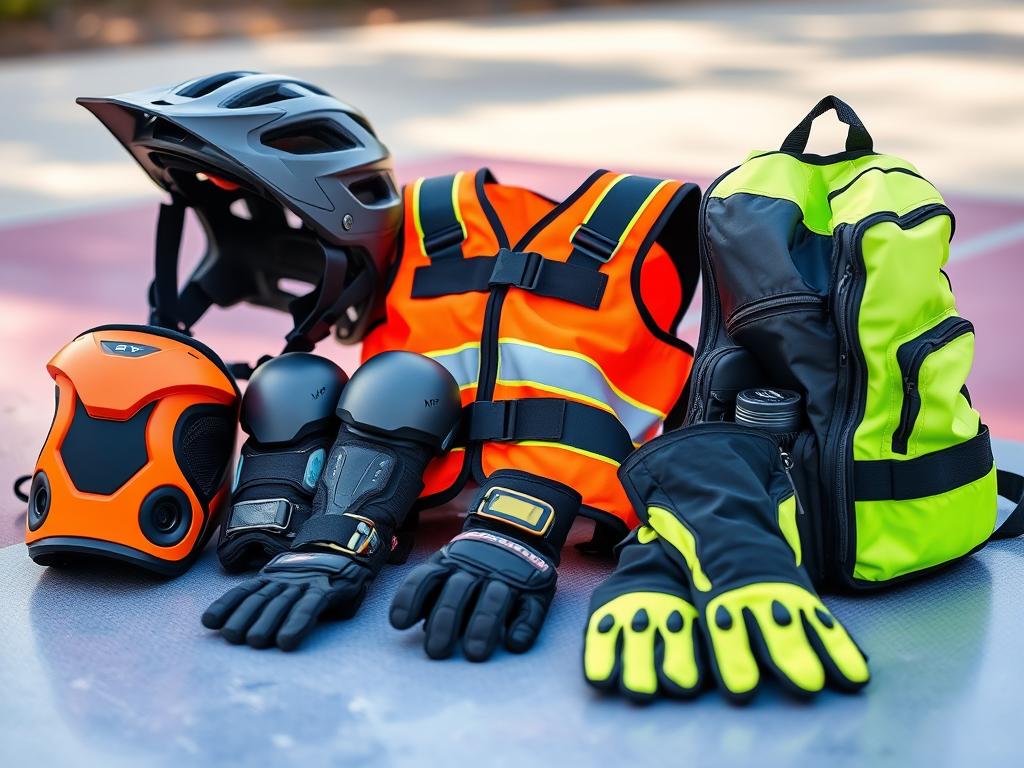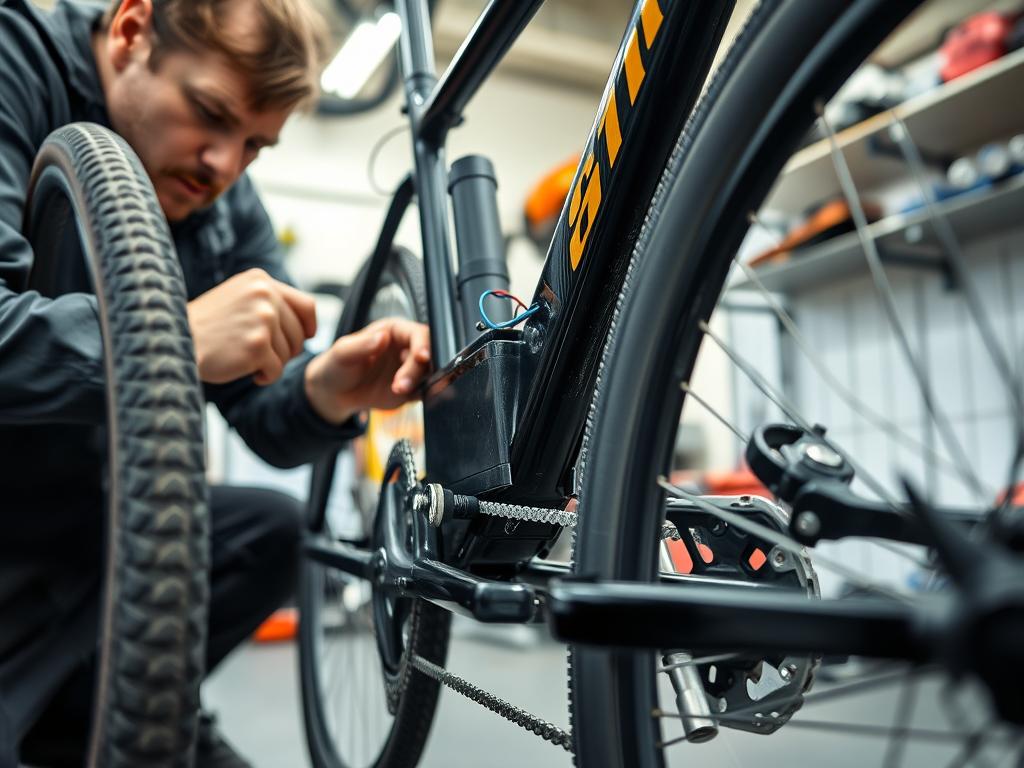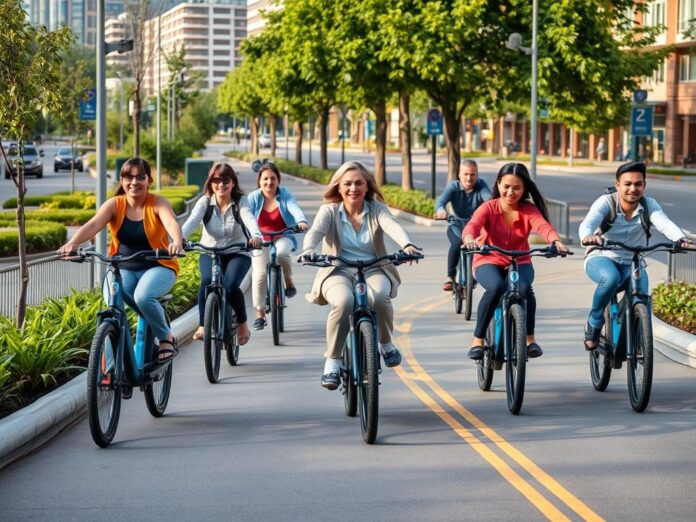The Baby Boomer generation is aging, and this will change how we move around. By 80, 32% of Americans might face mobility issues. E-bikes could be a big help for seniors and those with mobility problems.
E-bikes are easier to use than regular bikes. They give a feeling of freedom and help people connect with their community. For those with physical or mental challenges, e-bikes offer a big relief. They make riding easier and less tiring.
Also, e-bikes are more stable. This is great for those who have trouble balancing or need extra support while cycling.
Key Takeaways
- E-bikes offer a critical mobility solution for the 32% of Americans who will develop travel-limiting disabilities by age 80.
- Adaptive e-bike models, such as tricycles and recumbent bikes, cater to the unique needs of seniors and individuals with physical limitations.
- E-bikes provide a sense of independence and connection to the community, particularly for those with cognitive and physical impairments.
- The electric assist and stable design of e-bikes make them easier to ride and navigate for people with limited mobility.
- Targeted awareness campaigns and education programs can help bridge the knowledge gap between the potential and reality of e-bikes for older adults and individuals with disabilities.
Understanding e-Bikes and Their Benefits
Electric bicycles, or e-bikes, are changing how people with limited mobility stay active and independent. They have an electric motor that helps riders pedal, making it easier to go further. As [https://ebikesus.com/electric-bikes-for-senior-mental-health/] e-bikes become more popular, it’s key to know their benefits. They can greatly improve the lives of seniors and those with disabilities.
What is an e-Bike?
An e-bike is a bike with an electric motor that helps when you pedal. This makes cycling easier and more fun for those who can’t pedal as much. E-bikes come in many styles, meeting different needs and likes.
Advantages for People with Limited Mobility
- Improved mental health and well-being: Riding an e-bike can boost confidence and reduce stress. It gives a sense of freedom and independence.
- Enhanced physical well-being: E-biking is low-impact, improving heart health and muscle strength. It’s easy on the body.
- Increased mobility and independence: E-bikes let riders go further and overcome physical barriers. They make exploring easy.
Environmental Impact of e-Bikes
E-bikes also help the environment. They don’t produce emissions, reducing air pollution and saving resources. They use much less energy than cars, making them a green choice for travel.
| E-Bike Model | Key Features | Suitability for Seniors/Disabilities |
|---|---|---|
| Xplorer eBike | Step-through frame design, wide padded seat, adjustable handlebars | Prioritizes comfort, ease of use, and safety features for seniors |
| Comfort Cruiser EBike | Cushioned seat, suspension system, built-in lights for safety | Designed for a comfortable and secure riding experience |
| Adventure Hybrid EBike | Combines features of mountain and city bikes for versatility | Suitable for seniors who desire a range of terrain options |
As [https://ebikesus.com/electric-bikes-for-senior-mental-health/] e-bike tech gets better, these bikes are becoming more available and suited for seniors and those with mobility issues. They focus on comfort, safety, and being green. E-bikes are changing how people with disabilities move and feel independent.
Essential Safety Gear for e-Bike Riders
When it comes to e-bike safety, the right gear is key. The right equipment can prevent injuries and ensure a safe ride. Let’s look at the must-have safety gear for every e-bike rider.
Helmets: Choosing the Right One
A properly fitted helmet is crucial for e-bike riders. Over 70% of fatal bicycle accidents involve head injuries. This shows how important a helmet is in absorbing impacts.
Look for a helmet that meets safety standards and fits well. It should also have good ventilation and be adjustable. Impact-resistant materials are a plus for extra protection.
Visibility Gear: Lights and Reflective Clothing
Being visible on the roads is key for e-bike riders. Studies show that reflective gear can cut accident risk by up to 50% in low light. Make sure your e-bike has bright lights to be seen by others.
Wear high-visibility clothing like reflective vests or jackets. This is especially important during dusk or night rides.
Additional Protective Equipment
- Gloves: Protect your hands from abrasions and cuts, with nearly 25% of cycling injuries involving the hands.
- Knee and Elbow Pads: Safeguard your joints and reduce the severity of road rash injuries.
- Cycling Shorts: Padded cycling shorts can help prevent discomfort and minimize the risk of groin or pelvic injuries.
- Eye Protection: Wear sunglasses or prescription cycling glasses to shield your eyes from debris, wind, and UV rays.
- Sturdy Footwear: Choose shoes with good traction and support to prevent foot or ankle injuries, which account for 30% of e-bike accidents.
Investing in quality safety gear is an investment in your well-being. By focusing on injury prevention, you can enjoy your electric bicycle more confidently and safely.

How to Choose the Right e-Bike
Choosing the right e-bike for those with limited mobility is important. Look for adaptive options like tricycles and recumbent bikes. Also, consider features that make riding stable, easy, and powerful.
Types of e-Bikes Suitable for Limited Mobility
For those with limited mobility, certain e-bikes are better. Tricycles, quadcycles, and recumbent bikes offer more stability and support. These designs make riding more comfortable and accessible.
Key Features to Look For
- Stability: E-bikes with a low center of gravity and sturdy frame are more stable.
- Ease of Mounting and Dismounting: Features like a step-through frame make getting on and off easier.
- Adjustable Settings: Adjustable handlebars, seats, and pedals fit individual needs.
- Appropriate Motor Power: Choose a motor that matches your physical abilities.
Test Riding Before Purchase
Test riding different e-bikes is key before buying. Talk to e-bike specialists who know about riders with limited mobility. They can help you choose the best e-bike.
| E-Bike Model | Key Features | Price Range |
|---|---|---|
| Lectric XP Step-Thru 3.0 EBike | Up to 65-mile range, 64-pound weight capacity up to 330 pounds, 4.9/5 customer rating | $1,177 – $1,577 |
| SixThreeZero Electrified EvryJourney 250W Tricycle | Up to 50-mile range, 15 mph top speed, 300-pound weight capacity, 30-day trial | $1,899 – $2,199 |
| Aventon Abound EBike | 143-pound rear cargo weight limit, user-friendly design | $1,599 – $2,099 |
“Choosing the right e-bike is essential for individuals with limited mobility, as it can profoundly impact their independence and quality of life. By considering adaptive options and key accessibility features, riders can find an e-bike that truly meets their needs.”
Preparing for Your e-Bike Ride
Before you start your e-bike ride, make sure you’re ready. Check your health and talk to a doctor if you have concerns. E-bikes can go faster than regular bikes, so know your limits and ride safely.
Assessing Your Physical Condition
Look at your fitness and any health issues that might affect riding. Think about your balance, stamina, and any mobility problems. Knowing your limits helps you ride safely and make smart choices.
Planning Your Route
Plan your e-bike route carefully. Consider the terrain, distance, and any obstacles. Choose routes that match your skills and fitness, with breaks as needed. Also, learn about e-bike laws and regulations to stay safe and legal.
Understanding Local Traffic Laws
It’s crucial to know and follow local traffic laws. Learn about speed limits, signaling rules, and where you can ride. This knowledge helps you ride confidently and avoid accidents or fines.
Don’t forget to pack essentials like sunscreen, water, ID, money, and a phone. Also, tell someone your route and when you’ll be back. These steps ensure a safe and enjoyable e-bike ride.

Practicing Safe Riding Techniques
As an e-bike rider, it’s key to learn safe riding skills. This keeps you safe and others on the road safe too. Knowing how to start, stop, and handle obstacles is crucial. It makes your rides better and lowers risks.
Starting and Stopping Safely
Starting and stopping right is vital for control. Start by slowly adding power and speed up gently. Don’t rush off, as it might make the back wheel slip and lose control.
When stopping, press the brakes smoothly. Let the bike slow down slowly. This keeps you stable and avoids sudden stops.
Navigating Obstacles
E-bikes can handle many terrains, but be careful. Slow down and stay steady on bumpy or uneven paths. Avoid quick turns or swerves to keep balance.
Plan your path and adjust speed and direction smoothly. This way, you can safely get past obstacles.
Communicating with Other Road Users
Talking to drivers, walkers, and cyclists is key for safety. Use hand signals to show where you’re going. Follow traffic rules and watch out for others.
Pass others carefully and give them enough space. This keeps everyone safe.
Learning these safe riding tips boosts your confidence and skills. Start with short rides and get better over time. Always put safety first when riding an e-bike.
| Safety Tip | Benefit |
|---|---|
| Wear a properly fitted helmet | Reduces the risk of head injury by up to 85% |
| Use hand signals to communicate with other road users | Improves visibility and predictability for safer interactions |
| Maintain your e-bike regularly | Ensures optimal performance and reduces the risk of mechanical failures |
| Ride defensively and stay alert | Helps you anticipate and respond to potential hazards more effectively |
“Riding an e-bike is a liberating experience, but it’s important to prioritize safety at every turn. By mastering the fundamentals of safe riding, you can enjoy the benefits of e-bike mobility while minimizing risks to yourself and others.”
Maintaining Your e-Bike for Safety
Keeping your e-bike in top shape is key for safety and longevity. Regular checks and tune-ups spot issues early, preventing big problems. Also, taking care of your battery and tires is vital for your e-bike’s performance and reliability.
Regular Inspections and Tune-Ups
Make it a habit to check your e-bike often. Look at the tires, brakes, and other important parts for wear or damage. A professional tune-up every few months keeps your e-bike running smoothly. This helps avoid sudden breakdowns and keeps you safe.
Battery Care and Maintenance
The battery is your e-bike’s heart. It needs proper care to last long. Always charge it fully before riding and avoid letting it drain completely. Store it in a cool, dry spot when not in use. Check the connections and replace the battery if it loses charge.
Keeping Tires in Good Condition
- Check your tire pressure regularly and inflate to the recommended PSI level, as specified by the manufacturer.
- Inspect the tires for any signs of wear, such as cracks, bulges, or uneven tread, and replace them if necessary.
- Consider using puncture-resistant tires or tire liners to reduce the risk of flats.
Regular maintenance and inspections keep your e-bike safe and reliable for years. A well-kept e-bike not only improves your ride but also prevents accidents and breakdowns. This keeps you safe on the road.

Navigating Different Terrains
It’s key to adjust your riding style for different terrains to keep your electric bike stable. This ensures a safe and fun ride. Whether on pavement or trails, knowing how to handle each terrain is crucial.
Riding on Pavement vs. Trails
When moving from pavement to trails, slow down and be careful. The surface change can affect your e-bike‘s stability. Always be alert and adjust your riding as needed.
On uneven paths, rocks, or gravel, use a light touch on the controls. Keep your balance by riding evenly.
Understanding Weather Conditions
Weather can greatly impact your e-bike’s performance and stability. Riding in the rain or on wet surfaces can make it harder to stop. Watch out for puddles and slippery spots, and slow down when braking.
Strong winds can also change how your e-bike handles. Be ready to adjust your riding to stay in control.
Techniques for Climbing and Descending Hills
Hills can be tough, but with the right skills, you can ride them safely. Use your e-bike’s adaptive e-bike technologies to help when climbing. Keep a steady pace.
When going down hills, brake carefully to control your speed. Lean forward to improve traction.
Practicing on different terrains builds your skills and confidence. Always put safety first when riding your e-bike.
“Adaptive equipment for biking typically consists of three- or four-wheeled devices; adaptations on two-wheeled bicycles are limited and require a motor and extra assistance.”
Managing Risks While Riding
As an e-bike rider with limited mobility, staying alert is key. Watch out for traffic, pedestrians, and road changes. This ensures a safe and fun ride.
Identifying Potential Hazards
E-bikes can go faster than regular bikes, raising accident risks. Look out for obstacles, uneven paths, and unexpected moves by others. Be ready to act fast if danger appears.
Strategies for Avoiding Accidents
- Keep a safe distance from cars to react to sudden changes.
- Ride defensively, expecting others’ moves and adjust your path.
- Use disc brakes for quick, safe stops in emergencies.
- Wear bright, reflective clothes to be seen better in the dark.
Knowing When to Disembark
E-bikes are convenient, but know your limits. If tired, uncomfortable, or losing control, stop and rest. Listen to your body and don’t overdo it. Safety first.
| Statistic | Insight |
|---|---|
| The e-bike market is projected to experience a compound annual growth rate of 9.01% between 2021-2028. | The growing e-bike market means more need for safety and education to avoid injuries. |
| Studies show that e-bike accidents result in more severe injuries than traditional bicycle accidents due to the higher speeds involved. | Riders with limited mobility must be especially vigilant and take appropriate safety precautions to mitigate the risks associated with the increased speed of e-bikes. |
| E-bike riders are more likely to sustain serious injuries such as fractures and head trauma compared to traditional cyclists. | Wearing proper safety gear, such as a helmet, is crucial to protect against the potential for severe injuries in e-bike accidents. |
“Riding an e-bike should be an empowering and enjoyable experience, but it’s essential to prioritize safety at all times. By being aware of potential hazards and taking proactive measures, you can minimize the risks and have a safer, more confident ride.”
Legal Considerations for e-Bike Riders
E-bikes are becoming more popular, and riders need to know the laws. In the U.S., e-bike rules change from state to state and even within cities. It’s important to stay updated.
Understanding State and Local Regulations
States have their own rules for e-bikes. For example, California has three types of e-bikes with different speed limits and age rules. Riders should check their local laws to follow them.
Insurance Options for e-Bike Owners
Even if insurance isn’t required everywhere, it’s a good idea to protect your e-bike. Some insurance policies might cover theft or damage. Looking into e-bike insurance can give you peace of mind.
The Importance of Registration
Some places require e-bikes to be registered, like cars or bikes. Registration helps track e-bikes and can protect riders. Keeping up with registration shows you’re a responsible rider.
As the e-bike world grows, riders must stay current with e-bike laws and regulations. Knowing your rights helps build inclusive e-bike communities. These communities support safe and green ways to get around.
Tips for Staying Confident and Comfortable
Starting your e-bike journey? It’s key to build your skills slowly. Begin with short, easy rides. Then, as you get more confident, ride further and tackle tougher terrains.
Being part of inclusive e-bike communities is super helpful. These groups offer support, share experiences, and teach new things. They help riders with limited mobility enjoy their rides more.
Don’t stop learning. Use online forums, workshops, and adaptive cycling programs to grow. Keep up with new tech and safety tips. This way, you’ll stay confident and comfortable on your e-bike.






